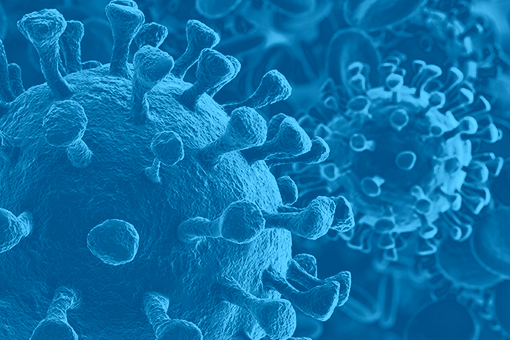Cardiac Injury in COVID-19 Infection

COVID-19, caused by the severe acute respiratory virus SARS-Cov-2, a novel coronavirus has developed into a pandemic with over 530 000 cases reported worldwide.1. For many this will be a self-limiting illness with only mild symptoms, however in some individuals this will be progressive, severe and ultimately fatal.
Troponin and COVID-19
Myocardial or cardiac injury, the latter including groups with abnormal electrocardiographs or echocardiograms irrespective of troponin, is recognised in early cases series with estimates of 7-23%2–5of patients admitted to hospital with typical COVID-19 symptoms.
Raised plasma troponin is associated with more severe infection, with patients requiring intensive care admission.3,6 Moreover, those admitted with COVID-19 infection and cardiac injury have increased mortality that may be as high 51%.4 The exact mechanism for the increase in mortality is unclear, however it likely represents a combination of inflammation, cytokine storm and hypoxia.7 The angiotensin converting enzyme 2 receptor, a membrane glycoprotein expressed in the heart and lungs, interacts with a spike protein on the coronavirus for endocytosis,8 which may support a role for direct viral toxicity. In patients that die from COVID-19 infection, the troponin levels appear to track disease severity, increasing gradually in the first phase of illness, and rising abruptly at day 16 of infection. In contrast, those surviving COVID-19 were reported to have plasma troponin that remained low throughout the course of infection.9
Myocarditis
In contrast to typical COVID-19 infection, there appears to be a cohort that present with primarily cardiac illness, in keeping with fulminant myocarditis. One case report10 describes a 37-year-old male with no pre-existing cardiac condition admitted with chest pain and shortness of breath. Echocardiography reported a dilated and severely impaired left ventricle, with thoracic CT showing both pleural effusions and pulmonary infection. Significant rises in troponin-I and N-terminal brain natriuretic peptide were measured. Supportive management with vasopressors and immunosuppression with methylprednisolone and immunoglobulin was successful with cardiac function normalising at one week.
A further case report detailed an individual with clinical features and investigations in keeping with pulmonary involvement but also features of fulminant myocarditis11. The patient was 61-year old male with pre-existing cardiac conditions. Early echocardiography was conducted and found severe left ventricular impairment with major elevation in troponin-I and N-terminal brain natriuretic peptide. He was managed with methylprednisolone and immunoglobulin, renal replacement therapy and extracorporeal membrane oxygenation, with left ventricular function normalising gradually.
Whilst type 1 myocardial infarction is possible in the context of COVID-19 infection and indeed many patients with poor outcomes have pre-existing cardiac disease, there are case reports of normal coronary angiography in the context of ST elevation, mimicking ST elevation myocardial infarction.12
Other biomarkers in severe infection
Biomarkers typically associated with inflammation are also elevated in COVID-19 infection. D-dimer is elevated in those admitted to ITU with associated increased mortality and also tracks the disease course.3,9 Similarly interleukin 6 is elevated in those admitted to intensive case, tracks disease severity and is associated with higher mortality9 Unsurprisingly, N-terminal brain natriuretic peptide is elevated in those with cardiac injury.4
Summary
Myocardial injury is common in patients admitted with COVID-19 infection, being associated with more severe disease and increased mortality. Clinicians should be aware of the significance of myocardial injury in patients admitted to hospital with COVID-19. Additionally, a subset of patients may present with predominantly cardiac symptoms and may represent fulminant myocarditis or overlapping presentation of both typical respiratory illness and myocarditis. These patients may benefit from immunotherapy and short term mechanical circulatory support to allow myocardial recovery.
.
KEY MESSAGES
- Elevation in troponin should alert clinicians to more severe and potentially fatal disease.
- D-dimer and Interleukin-6 are other useful markers in risk stratification.
- Early echocardiography may be useful to detect myocarditis in patients with significantly elevated troponin who are clinically deteriorating.
- Invasive angiography should be considered In the clinical context and not on the basis of abnormal troponin results alone.
.
Authors
Dr Gareth Barnes: Cardiology SpR - Royal Brompton & Harefield NHS Foundation Trust
Dr Shouvik Haldar: Consultant Cardiologist - Royal Brompton & Harefield NHS Foundation Trust
References
1. Worldometer. Worldometer.
2. Wang, D. et al. Clinical Characteristics of 138 Hospitalized Patients With 2019 Novel Coronavirus–Infected Pneumonia in Wuhan, China. Jama 323, 1061–1069 (2020).
3. Huang, C. et al. Clinical features of patients infected with 2019 novel coronavirus in Wuhan, China. Lancet 395, 497–506 (2020).
4. Shi, S. et al. Association of Cardiac Injury With Mortality in Hospitalized Patients With COVID-19 in Wuhan, China. Jama Cardiol 5, (2020).
5. Yang, X. et al. Clinical course and outcomes of critically ill patients with SARS-CoV-2 pneumonia in Wuhan, China: a single-centered, retrospective, observational study. Lancet Respir Medicine (2020) doi:10.1016/s2213-2600(20)30079-5.
6. Lippi, G., Lavie, C. J. & Sanchis-Gomar, F. Cardiac troponin I in patients with coronavirus disease 2019 (COVID-19): Evidence from a meta-analysis. Prog Cardiovasc Dis (2020) doi:10.1016/j.pcad.2020.03.001.
7. Driggin, E. et al. Cardiovascular Considerations for Patients, Health Care Workers, and Health Systems During the Coronavirus Disease 2019 (COVID-19) Pandemic. J Am Coll Cardiol (2020) doi:10.1016/j.jacc.2020.03.031.
8. Shereen, M. A., Khan, S., Kazmi, A., Bashir, N. & Siddique, R. COVID-19 infection: origin, transmission, and characteristics of human coronaviruses. J Adv Res (2020) doi:10.1016/j.jare.2020.03.005.
9. Zhou, F. et al. Clinical course and risk factors for mortality of adult inpatients with COVID-19 in Wuhan, China: a retrospective cohort study. Lancet (2020) doi:10.1016/s0140-6736(20)30566-3.
10. Hu, H., Ma, F., Wei, X. & Fang, Y. Coronavirus fulminant myocarditis saved with glucocorticoid and human immunoglobulin. Eur Heart J (2020) doi:10.1093/eurheartj/ehaa190.
11. * J. H. Z. et al. First Case of COVID-19 Infection with Fulminant Myocarditis Complication. doi:10.20944/preprints202003.0180.v1.
12. TCT. COVID-19 and the Heart: Insights From the Front Lines.
